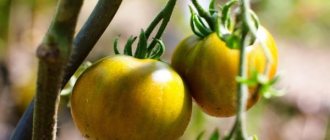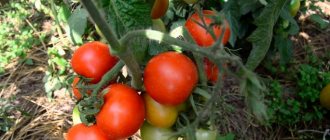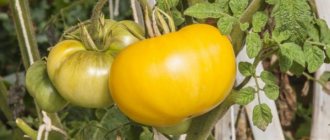Tomato Angela Gigant is a mid-season large-fruited variety. Brought out in the 2010s and intended for cultivation in open ground and greenhouses. It has large and attractive fruits, thanks to which it has earned the attention and positive reviews of amateur gardeners.
| Height | Landing location | Ripening time | Fruit color | Fruit size | Origin | Fruit shape |
| Tall | Greenhouse, Open ground | Mid-season | Reds | Large | Variety | Flat-round |
Description and characteristics of the variety
The variety is mid-season, the fruits ripen in 100-115 days. They are red in color and flat-round in shape. The weight of tomatoes ranges from 300 g to 1.5 kg and depends on the method of formation of the bush.
The plant is indeterminate (tall). The height can reach 250 cm, which makes it very important to place it correctly.
Tomatoes are tasty, sweet with a small amount of seeds and fleshy juicy pulp. They are successfully used in home preparations, cooking and eaten fresh.
Advantages and disadvantages
Considering the advantages of this tomato, we highlight:
- stable yield;
- good tolerance to short-term temperature drops;
- plant resistance to late blight and a number of other crop diseases;
- the possibility of sufficiently long-term storage of the harvested crop;
- excellent taste characteristics of tomatoes and large fruit.
Attention! The large size of the Angela Gigant tomato fruit is also its disadvantage. It will not be possible to preserve whole tomatoes, since they simply will not fit through the neck of the jar.
Other disadvantages of the variety relate more to the peculiarities of caring for tomatoes of this type - this is the regular removal of lateral shoots (stepchildren) and the need to tie the plant stems to a trellis or stake.
Advice. It is advisable to also tie up fruit clusters that are filling so that they do not break off under the weight of the fruit.
Plant characteristics
The bush grows on average up to 1.4 m in height, but individuals twice as tall can be found. Therefore, to prevent the bush from breaking, it requires tying to a support, as well as careful pinching. The garter to the support is probably the only drawback of this crop. Usually two stems are left for harvesting. In this case, the plant receives normal load and a decent harvest can be obtained.
In order to get a good harvest, you do not need to leave many branches. Even at the beginning of growth, it is necessary to monitor the crop and remove excess shoots that usually appear between the stem and leaf. Their removal is necessary, as the plant will waste extra energy and you will get less yield.
Growing tomatoes
Sowing of seeds is carried out 60-65 days before the planned transplant date. The timing is calculated individually, based on the climatic conditions and weather of the region. Before sowing, it is better to carry out preliminary inspection and preparation in order to increase the germination rate and accelerate the growth rate.
Growing seedlings
Treatment with disinfectants or a weak solution of potassium permanganate helps to increase the plant's immunity. To increase growth rates, the seeds of the Angela Giant variety are treated with stimulants.
For planting and growing seedlings, light, loose and soft fertile soil is used.
To grow tomato seedlings, any containers are used: boxes, individual cups or peat tablets. It is recommended to disinfect equipment with boiling water or a thick solution of potassium permanganate before use.
Drainage consisting of small stones, pebbles or expanded clay is poured into the bottom. Then the soil is laid to two-thirds of the volume and compacted. The seeds are deepened by 1 cm and covered with soil on top. Then water generously with warm water.
To maintain a constant level of humidity and temperature, the containers are covered with glass, a lid or covered with plastic film.
Picking up seedlings
When the seedlings have their first true leaves, the tomato picking procedure is carried out.
Before transplanting, seedlings are watered abundantly to make the soil softer. Then, using a spatula, the seedling is carefully dug under the root and transferred to a larger container.
It goes deep to the cotyledon leaves. After the procedure, the tomatoes are watered abundantly. Then no watering is performed for 7 days.
Feeding of seedlings is carried out 1-2 times. First after the dive, then a week before the transplant. Water the seedlings with warm water at the root as the top layer of soil dries.
It is recommended to plant seedlings in soil prepared in the fall.
Tomatoes are planted in shallow holes. There is no need to water the bushes for a week. But when planting in open ground, it is advisable to provide shelter from sunlight, wind and frost.
Features of care
After planting the Angela Gigant tomatoes in a permanent place, it is necessary to install supports or trellises on the bed for gartering the bushes.
As the bushes grow, tying is carried out several more times. At the same time, the stepsons and excess leaves are removed. Watering is done once every few days with warm, settled water at the root.
After each watering, the soil is loosened to enrich it with oxygen and prevent the formation of a hard earthen crust.
The Angela Giant variety is high-yielding. Due to its resistance to cold weather, it can be grown in the northern regions of the country in protected ground.
Features of cultivation and storage
When growing indeterminate varieties, they stock up on wooden pegs or build a support for tying in advance. Without this operation, the plant breaks under its own weight of vegetation and fruits. In cases where tomatoes grow above 200 cm, it is recommended to attach them to trellises.
Regularly, unnecessary shoots, branches, and leaves are removed from the bushes, forming the main stem.
If bad weather is possible in the form of hail, strong winds, frosts, build a shelter made of fabric or film to protect the tomatoes.
Tomatoes can be stored for a long time in a dry, dimly lit place. The main thing is to go through them from time to time and remove spoiled copies.
Features of agricultural technology of giant tomatoes
Seeds are sown for seedlings in the 1st-2nd decade of March.
For better germination, pre-soak for 10 hours in Epin or Zircon. How to care for seedlings:
- irrigation with warm water from a spray bottle;
- fertilizing with “Strong” 1 time in 10 days;
- diving with 3 true leaves.
Ripe tomatoes are stored for 2-3 months in dark, cool rooms.
Seedlings are transplanted at the age of 50-55 days. The beds are selected taking into account crop rotation. Good predecessors are melons, carrots, beets.
3 bushes are placed per 1 m2. Planting pattern 50*60 cm.
For significant yields:
- bushes lead to 1-2 shoots;
- mulch with straw or hay in a 10 cm layer;
- apply fertilizers during flowering, setting, ripening;
- water 2 times a week, 6-7 liters per bush.
Mid-season / Tall
User rating: 4/5
Mid-season / Tall
User rating: 5/5
Mid-season / Tall
When developing varieties of giant tomatoes, the main goal of breeders was to achieve larger sizes and improve the taste of the fruit. As a result, tomatoes with large fruits and an original sweet taste have been developed. The pulp of giant tomatoes is pleasant to the taste and contains an increased amount of sugars, lycopene and provitamin A.
Perhaps the disadvantage of giant tomatoes can be considered the specificity of their use - for salads and processing for juice. They are not suitable for preservation due to their size; their shelf life is generally not great. The weight of the “giant” fruit usually ranges from 200 to 500 grams. And for growing in a garden or summer cottage - interesting, exciting and appetizing.
The characteristics and description of the variety indicated on the packaging must be read before purchasing seeds - fundamental points may be indicated there. Prepare the seeds for planting - disinfect them in a solution of potassium permanganate, rinse them in warm water and put them in a cool place for several days. Next, the seeds are soaked, and when the first shoots appear, they are planted in prepared pots.
The most important thing when deciding to grow a giant tomato is to purchase high-quality selection seeds. In Moscow there are representative offices of almost all companies involved in the licensed sale of seeds.
Growing giant tomatoes is not particularly difficult. Many varieties are suitable both for open ground in the southern regions and for growing in Siberia in greenhouse conditions.
The requirements for seeds, seedlings, planting time and plant care are similar to other varieties.
An important feature of successful cultivation of giants is the obligatory timely staking of the stem, topping and pinching of the plant. Depending on the desire to get fruits of a certain size, it is necessary to form a bush. Usually 2 stems are left, but for growing particularly large specimens - only 1 stem. As the fruit grows, be sure to strengthen the branches with stands.
For connoisseurs of excellent taste and salad lovers, breeders developed the large-fruited Pink Giant tomato variety. The tall plant develops well both in open beds and in a greenhouse. If you sow the seeds correctly and properly care for the plant throughout the growing season, you can get an excellent harvest.
The Pink Giant tomato variety was included in the State Register of the Russian Federation in 2001 and is designed for cultivation in open ground and film shelters in vegetable gardens and personal plots.
According to the originator's description of the variety:
- belongs to the mid-early variety, 115-125 days pass from mass germination to the appearance of the first fruits;
- plants of indeterminate type, the height of which reaches 1.5-1.7 m;
- tomato leaves of the Pink Giant variety are green, medium in size;
- the inflorescences are simple, sometimes of an intermediate type: the first raceme is formed above the 9th leaf, the next - after 3 leaves. The peduncle has an articulation;
- The fruit is flat-round, strongly ribbed. When unripe, it is green in color with a dark green spot next to the stalk; when ripe, it is pink in color;
- The tomatoes taste sweet, juicy, and are intended for salad purposes.
The yield of the variety is 5.8-6.4 kg/m2 with an average fruit weight of 350 g.
The Pink Giant variety has beautiful large tomatoes that are used to make salads and juices. They are also used to make pastes or ketchup. Tomatoes are not suitable for canning due to their large size and tender flesh, which peels off during heat treatment.
Among the valuable characteristics of Pink Giant tomatoes, gardeners who grew them highlight:
- large fruit and excellent taste;
- average resistance to many diseases;
- endurance in relation to temperature changes and lack of moisture.
The disadvantages include the need to form and tie up bushes, which can be difficult for beginners.
In the southern regions, tomato seeds are immediately sown in open ground. In colder climates, only cultivation through seedlings is possible. Sowing is carried out 50-60 days before planting in the ground.
Store-bought seeds are sown immediately, and those collected with one’s own hands are prepared in advance before planting. To do this, you need to soak them in an aqueous salt solution for 5 minutes to reject those that float. Rinse the remaining seeds with clean water.
Each vegetable grower has his own way of germinating tomato seeds. One of the options:
- prepare a solution by adding a teaspoon of nitrophoska or wood ash to 1 liter of water;
- leave a fabric bag with seeds in it for 24 hours. The solution temperature should be 20 °C;
- then cool the seeds in the refrigerator for 1-2 days, placing the bag in a plastic bag.
After this, they are immediately placed in a common box. Containers with planted seeds are left in a bright place. Most often this is a window sill. To speed up the emergence of seedlings, the boxes are covered with film, which is removed as soon as the first shoots appear.
Caring for Pink Giant tomato seedlings involves timely watering, providing an additional light source and maintaining the room temperature within 20-22 °C.
To prevent the sprouts from being pulled out, the boxes are alternately turned to the window with one side or the other.
Fertilizing with complex fertilizers is carried out after the appearance of 1 true leaf on all sprouts. To do this, take a teaspoon of tomato fertilizer per liter of water. Water this solution under the root. The second feeding is carried out in the same way, but after the appearance of the 3rd true leaf.
Seedlings are picked after 2-3 true leaves appear. Weak and diseased plants are removed. The rest are moved to individual pots with soil. If the sprouts are elongated, then when picking, the stems need to be buried halfway, not reaching the cotyledon leaves.
Hardening is carried out in April - May. To do this, open the window day and night. On warmer days, the boxes are placed on the balcony and the windows are opened for 2-3 hours for about 3 days. After this, they take it outside for the whole day in the shade. The weather should be warm and sunny, but without wind or rain. During hardening, the soil must be moistened, otherwise the sprouts will wither.
Tomatoes are planted in open ground from May 25 to June 5. When transplanting, the distance between the bushes is left at least 50-60 cm. Experienced vegetable growers advise planting seedlings according to a 70 by 70 cm pattern.
Immediately after planting the tomato, stakes or trellises are placed to secure the stems. To do this, you need to dig in wooden or metal supports so that the level above the ground is at least 2 m.
For trellises, run wire between the posts. As the plants are pulled out, the stems need to be secured to the horizontal bar with ropes.
Tomato branches have difficulty holding heavy brushes, so they are also tied up or supported.
When growing tomatoes of this variety, they are fertilized with complex mineral fertilizers. Nutrients are added to the soil 10-12 days after planting the seedlings. To do this, about 30 g of mineral components are dissolved in 10 liters of water. The following times, the amount of fertilizer is increased to 50 g.
After watering, fertilizing and rain, a crust appears on the soil, preventing oxygen from penetrating to the roots of the plant. Timely loosening of the soil solves this issue. Spreading mulch over the bed after heavy rain or watering also helps retain moisture in the soil. It prevents the formation of crust, and the problem of frequent loosening of the soil under the bushes disappears.
The formation of the Pink Giant bush is carried out in 1-2 stems. No more than 4 flowers are left on each inflorescence. To get a good harvest, pinching is carried out once a week.
READ MORE: Tomato king early characteristics and description of the variety, yield with photos
Reviews from vegetable growers
According to reviews from experienced gardeners, you should definitely try to grow the Pink Giant tomato variety at least once.
We have been growing these tomatoes for several years now and plant them in a greenhouse. As for care, the variety requires time and dedication, but it is worth it. The tomatoes taste sweet (slightly sour), juicy, very large, with a thin skin. I grow them mainly for salads due to their size.
Galina This variety has been bred in our family for a long time. Used for making juices. They were grown both in greenhouses and in open ground. In the greenhouse the bushes were taller and more fruits were produced, but despite this, the excess inflorescences were removed to obtain larger fruits.
This variety requires a lot of attention and care, but the effort is worth it.
Origin of giant varieties
When developing varieties of giant tomatoes, the main goal of breeders was to achieve larger sizes and improve the taste of the fruit.
As a result, tomatoes with large fruits and an original sweet taste have been developed. The pulp of giant tomatoes is pleasant to the taste and contains an increased amount of sugars, lycopene and provitamin A. Perhaps the disadvantage of giant tomatoes can be considered the specificity of their use - for salads and processing into juice. They are not suitable for preservation due to their size; their shelf life is generally not great. The weight of the “giant” fruit usually ranges from 200 to 500 grams. And for growing in a garden or summer cottage - interesting, exciting and appetizing.
When developing varieties of giant tomatoes, the main goal of breeders was to achieve larger sizes and improve the taste of the fruit.
As a result, tomatoes with large fruits and an original sweet taste have been developed. The pulp of giant tomatoes is pleasant to the taste and contains an increased amount of sugars, lycopene and provitamin A.











